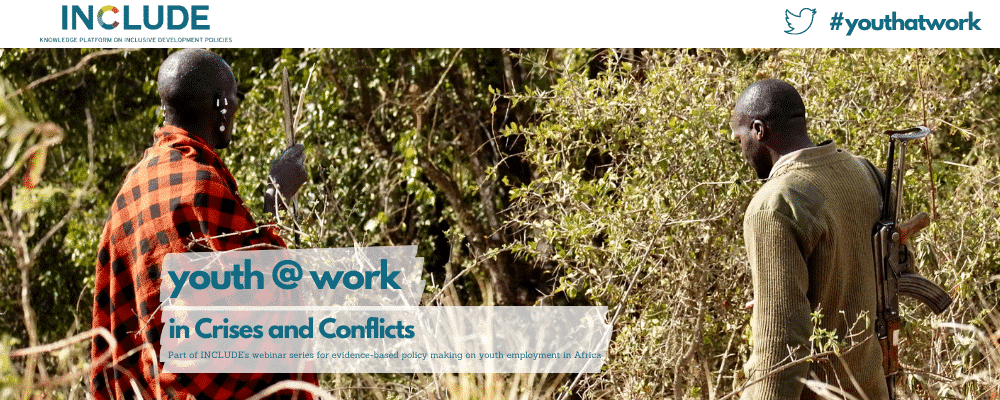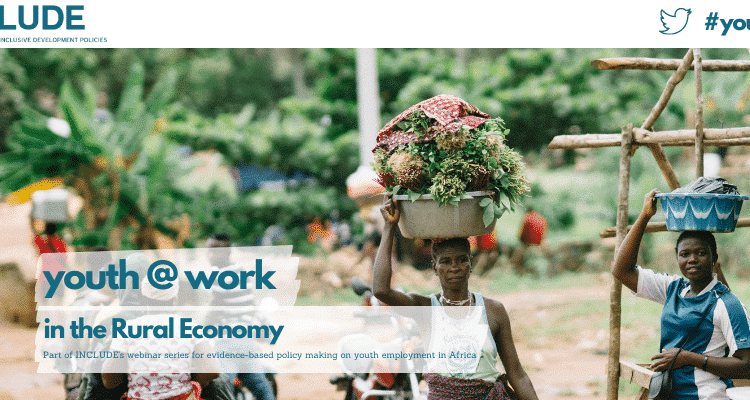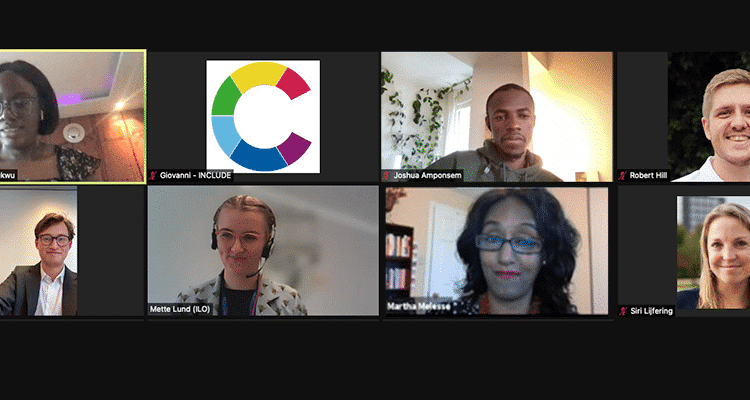
How do crises and conflicts affect youth employment and how can employment be sustained in conflict and crises circumstances? These were the main questions of this week’s Youth@Work webinar, hosted by INCLUDE, with the support of Canada’s International Development Research Centre (IDRC) and the International Labour Organization (ILO). During the Youth@Work webinar series, researchers, practitioners, policymakers and youth come together to share knowledge and good practices on youth employment in Africa. This article presents the key insights emerging from the online event.
The Covid-19 pandemic continues to take a toll on African lives and economies, leading the region into its first recession in 25 years. Estimates show that the pandemic could push up to 40 million people in Sub-Saharan Africa into extreme poverty. Crises such as the ongoing Covid-19 pandemic, but also other economic, social and political crises and conflicts affect countries with varying intensity, depending on their situation and prior vulnerabilities. Young people, especially young women, are particularly sensitive and even more so when they are poorly qualified and live in rural areas where infrastructure is scarce. Some crises, such as economic, environmental and conflict-related crises, are structural and can sometimes last for decades. This forces young people to adapt and develop survival strategies which often turn out to be risky or even dangerous. When it comes to youth employment strategies, it is therefore critical to understand how conflict and crises affect youth and how employment can be sustained and stimulated in these circumstances.
No such thing as a single crisis
Verena Richardier, who is affiliated with Triangle UMR 5206 laboratory and the Ecole Normale Supérieure de Lyon, shared some important insights from her evidence synthesis paper on youth employment in crisis and conflicts. The paper distinguishes between two types of crises. First, long-standing crises and lasting tensions, which are structural crises that continue over a prolonged period of time such as civil war, structural poverty and climate change. The second is sudden shocks, which include pandemics, natural disasters, political crises and economic shocks. However, what Richardier shows, is that these two types of crises do not exist next to each other, but are connected and intertwined. In a structurally deficient context with issues like poverty, unemployment, corruption, sudden shocks can aggravate existing vulnerabilities and lead to disastrous situations. As such, as Richardier states: ‘There is no such thing as a single crisis’.
Youth are found to be the most affected by the intertwining of crises as they mostly work in the informal sector and already face more uncertain prospects for finding decent work. In addition, crises can also affect youth’s future job perspectives by interrupting their education and causing delays in their professional integration. In the case of pandemics and other health crises, young women are particularly affected and vulnerable, as they tend to provide unpaid care to their family members. Therefore, according to Richardier, when it comes to stimulating youth employment in crisis-affected areas it is important to take a holistic approach that looks at the various barriers that youth are facing and how these can best be addressed. Supporting the informal economy and providing an extension of policies such as social safety nets could be of crucial importance in this regard.
Myth-busting links between youth and violence
Marjoke Oosterom, research fellow at the Institute of Development Studies at the University of Sussex, agrees with Richardier that it is important to pay specific attention to young people in crises and political conflict, but warns that we have to be careful not to replicate the persistent myth that youth unemployment is directly linked to violence and instability. As many examples show, the majority of youth are not engaged in violence or crime at all, despite them facing the same conditions as those that do, Oosterom states. ‘Youth unemployment might be one of the grievances, but it never is the sole reason for violence and conflict’. As such, youth employment shouldn’t be promoted as the silver bullet for addressing crises and conflict warns Oosterom. Not just because this is incorrect, but it also undermines the very real claims and grievances youth have concerning the unequal wealth distribution, corruption, lack of access to health care and police brutality. Moreover, as Oosterom explains, protests around these issues show that many of the problems that youth are facing are not youth-specific, but are in fact structural economic and political issues.
Nigerian youth representative, Rafiu Lawal, founder of the Building Blocks for Peace Foundation and coordinator of the UNOY Peacebuilders, agrees with Oosterom’s point that youth unemployment should not be equated with violence and instability and adds that this is exactly what could be seen with the EndSARS protests against police brutality in Nigeria. ‘What young people want is about far more than just jobs. We want our basic human rights to be respected. We want political, social and economic inclusion.’ According to Lawal, in order to stimulate youth employment, programmes have to address structural barriers that are preventing youth from participation in society, only then can programmes address youth employment in crises and conflicts.
Vested interests
Reflecting on the other contributions, Quirine Timmerman, policy officer at the Dutch Ministry of Foreign Affairs, shared her personal experience working in conflict and post-conflict countries such as Angola, Rwanda and Burundi. One key issue to understand, Timmermans explained, is that conflicts are connected to vested, political and economic interests. Young people who are engaged in these conflicts are as such in many cases not the instigators of conflict, but are actually manipulated by a small group of influential people to do their bidding. In order to address violence and instability, it is therefore crucial to find out who is in charge and influence those actors. ‘We tend to focus on the outcomes of crises, but not on the interests that are connected to those’, Timmerman stated.
Although she acknowledges Oosterom’s point that focusing on youth employment is not the only solution to conflict and instability, she underscores that it can be an important strategy to change the mindset of those in charge. Making it personal by asking them ‘What kind of country would they want their children to live in? Wouldn’t they want their children to be able to find work?’ can bring about the mindset shift we need to make a change. ‘There might be more room to manoeuvre here, than we think’, concludes Timmerman.
Entrepreneurship as an avenue for change
Khansa Alhag, Director at the Global Entrepreneurship Network (GEN) Sudan and managing partner at 249 Startups joined the webinar from Sudan, a country currently in the midst of a political crisis. In order to work on youth employment in a conflict setting, it is crucial according to Alhag that international organisations and other actors are aware of the specific political conflict dimensions that are taking place in the context that they are operating in. Even if they don’t want to play a political role, they must be aware of the political consequences of their actions, because investing in the wrong place could exacerbate tensions and lead to new conflicts, warns Alhag.
According to Alhag, encouraging and supporting entrepreneurship could in this regard play a critical role as entrepreneurs do not only generate income and create jobs for youth, but also have an important social role in times of crises, because they give youth hope for a better future. According to Alhag, supporting the creation of a conducive entrepreneurship ecosystem could therefore be a worthwhile investment when it comes to working on youth employment in crises and conflicts.
Youth participation
As in the previous webinars on the green economy and the rural economy, the speakers in this session also highlighted the need for the inclusion of youth in discussions around youth employment policies. Lawal in this respect suggested that the UN Security Council adopted resolution 2250 on Youth, Peace and Security could be a good starting point. Especially, the pillar that centres on participation offers promising avenues for inclusive participation of youth in decision-making processes. Following Lawal’s recommendations, moderator of the debate Chiamaka Nwachukwu, added youth quotas might be another interesting avenue to explore as this can promote leadership and participation of youth in governance structures and policy agendas.
Finally, as most participators acknowledged; youth employment might not be a silver bullet when it comes to navigating crises and conflicts, however, decent forms of employment do contribute strongly to the promotion of peace and are therefore an important goal to work on.

